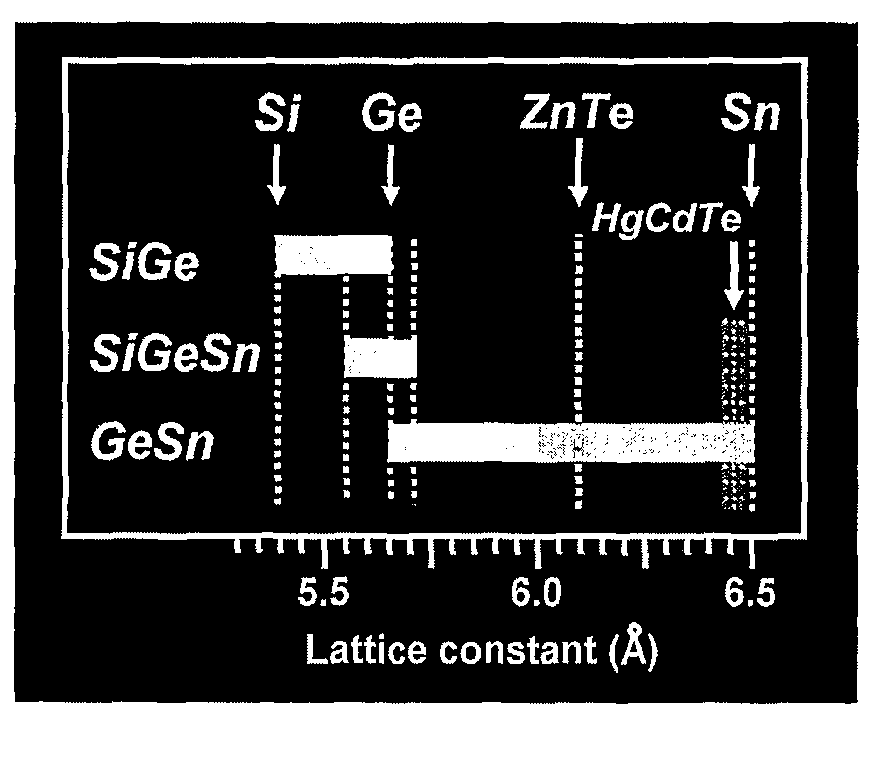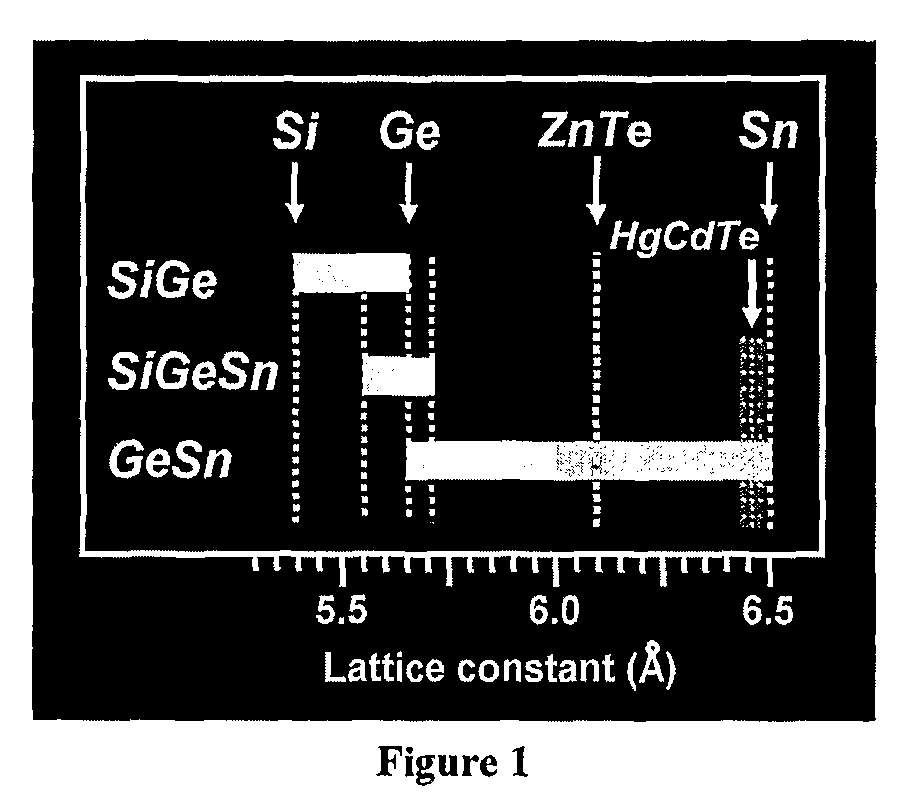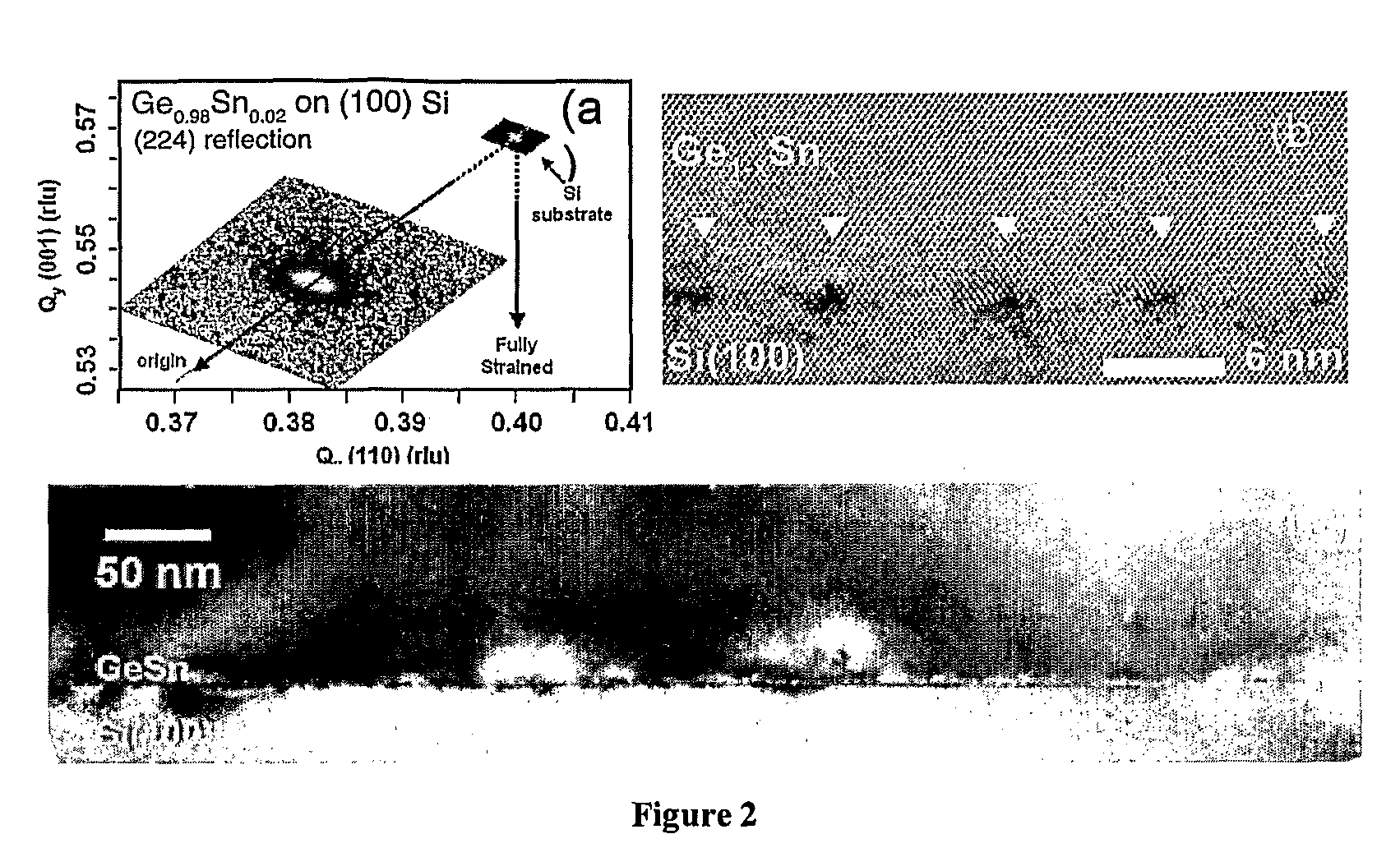GeSiSn-based compounds, templates, and semiconductor structures
a technology of gesisn and compounds, applied in the direction of silicon compounds, crystal growth processes, polycrystalline material growth, etc., can solve the problems of high defect density, increased defect density, and increased defect density
- Summary
- Abstract
- Description
- Claims
- Application Information
AI Technical Summary
Benefits of technology
Problems solved by technology
Method used
Image
Examples
example 1
GeSn Surface Preparation And Examples of Si Integration
[0111]The GeSn buffer layer surface can be prepared by extremely simple chemical cleaning methods for subsequent ex-situ epitaxial growth. This is an essential enabling step that further demonstrates the feasibility of these materials as versatile templates for integration with Si. GeSn films with the desired thickness and Sn concentration are grown on Si substrates with a nominal size of 2.5×3.0 cm2. A single typical deposition experiment produces a batch of 4-10 wafers. We routinely characterize several randomly selected samples from each batch using RBS (Rutherford backscattering spectroscopy), atomic force microscopy (AFM) and x-ray diffraction to evaluate the quality of the films. RBS ion channeling is used to gauge qualitative the presence of threading dislocations that propagate across the layer thickness. In most samples, the ratio of the aligned versus the random peak heights (χmin), which measures the degree of crystal...
example 2
Examples Of Growth Of III-V Materials On Si Via Si—Ge—Sn Buffer Layers: GaAs, AlGaAs, GaAsSb and InGaAs
[0113]As a demonstration of the applicability of the GeSn film as buffer layers for integration of semiconductors with Si we explored direct growth of III-V compounds on GeSn / Si substrates. We grew pure GaAs (a=5.65 Å) layers as well as AlGaAs / GaAs quantum well structures on nearly lattice-matched GeSn (a=5.67 Å) buffer layers. For comparison we simultaneously conducted growth of the same materials on GaAs substrates via homoepitaxy. In both cases we have determined the structural, morphological and optical properties of the films by XTEM, AFM, photoluminescence (PL), and high resolution XRD. We find that the quality of the films grown on GaAs substrates (including PL peak positions) is comparable to that grown on GeSn / Si buffer layers indicating that our methodology in this case works and our approach may offer a convenient and low cost route to the integration of compound semicon...
example 3
References for Example 3
[0155][1] Resonant cavity enhanced InGaAs photodiodes for high speed detection of 1.55 μm infrared radiation, Kaniewski J., Muszalski J., Pawluczyk J., Piotrowski J., Proceedings of SPIE-The International Society for Optical Engineering (2005), 5783 (Pt. 1, Infrared Technology and Applications XXXI), 47-56.[0156][2] InGaAs-on-Si single photon avalanche photodetectors, Kang Y., Lo Y.-H., Bitter M., Kristjansson S., Pan Z., Pauchard A., Applied Physics Letters (2004), 85(10), 1668-1670.[0157][3] High Performance 0.1 μm GaAs Pseudomorphic High Electron Mobility Transistors with Si Pulse-Doped Cap Layer for 77 GHz Car Radar Applications, Kim S., Noh H., Jang K., Lee J., Seo K., Jpn. J. App. Phys. 44, 2472-2475 (2005).[0158][4] Growth of AlAsSb / InGaAs MBE-layers for all-optical switches, Cristea P., Fedoryshyn Y., Jaeckel H., J. Cryst. Growth 278(1-4), 544-547 (2005).[0159][5] Improved characteristics of metamorphic InAlAs / InGaAs high electron mobility transistor ...
PUM
| Property | Measurement | Unit |
|---|---|---|
| thickness | aaaaa | aaaaa |
| thickness | aaaaa | aaaaa |
| boiling point | aaaaa | aaaaa |
Abstract
Description
Claims
Application Information
 Login to View More
Login to View More - R&D
- Intellectual Property
- Life Sciences
- Materials
- Tech Scout
- Unparalleled Data Quality
- Higher Quality Content
- 60% Fewer Hallucinations
Browse by: Latest US Patents, China's latest patents, Technical Efficacy Thesaurus, Application Domain, Technology Topic, Popular Technical Reports.
© 2025 PatSnap. All rights reserved.Legal|Privacy policy|Modern Slavery Act Transparency Statement|Sitemap|About US| Contact US: help@patsnap.com



